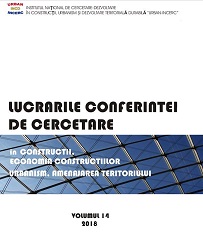Rezistenţa la foc a materialelor cu modificare de fază (PCM)
Fire resistance of phase changing materials (PCM)
Author(s): Horaţiu Gabriel DRAGNE
Subject(s): Architecture
Published by: INCD URBAN-INCERC
Keywords: phase changing materials; fire protection; fire resistance
Summary/Abstract: Fire statistics show that in recent years in Romania, despite the efforts made by military firefighters, the number of fires with significant casualties and material damage to households has remained high. The emergence of new building materials increases the risk of fires if they are not adequately assessed from the point of view of fire resistance. Phase changing materials are increasingly used to reduce the energy consumption of modern buildings. These materials have the potential to change the dynamics of compartment fires by altering the energy balance of the compartment, and there is little research on how these materials behave in the event of a real fire. Changes in fire dynamics may be due to changing the heat load in a compartment or by reducing the fire propagation time. The objective of this research is to quantify how Phase Change Materials (PCM) work in realistic fire scenarios. Between 2000 and 2005, in Romania, about 50,000 fires occurred in homes and households, accounting for an average of about 69% of the total fires produced. Of the total fires in the households, there were: 58% in the rural area and 42% in the urban area. In building fires, the main causes are: open fire (16%), smoking (12%), children's play with fire (10%), deliberate actions (9%), smoke or uncleaned chimney (12%), improper or Improvised Electrical Installations (20%). Out of the total number of fires, about 38% of them occur in household annexes and about 18% in bridges and roofs, 22% in living quarters and food preparation. Building design is a complicated multidisciplinary process that requires the balance of many factors, including, but not limited to: aesthetics, cost, functionality, structural stability, fire, and durability. In recent years, sustainability has become an increasingly important factor, with a focus on reducing carbon emissions and saving energy in the built environment. New building materials are rapidly developed to progressively achieve targets that want to increase the sustainability of the built environment before their fire performance can be properly assessed. Phase Change Materials (PCM) is a group of innovative building materials that are becoming more and more popular due to their potential to reduce the energy consumption of buildings. These materials are liquid during the day, absorbing energy from the environment and reducing the need for cooling and then solidifying during the night, releasing the stored energy and reducing the need for heating. Suitable materials must have a melting point around the intended interior temperature, be economically viable and have a high latent heat. The most commonly used material that fits these criteria is paraffin wax. This wax is often contained in polymeric microcapsules and added to the gypsum matrix to form a rigid wall or ceiling plate. In spite of their use as compartments, there should be no overall risk assessment of this material in the event of a real fire. Current studies deal with non-flammable compartment shells, given the importance of preventing the spread of fires between compartments. Thus, the flammable nature of PCMs contained in the wall layers of the compartments presents an unqualified fire risk at present. In view of existing knowledge, designers cannot quantify the effect these materials will have on the fire at the design stage and on the fuel load inside the compartment. Current fire test methods according to the standards in force are useful for comparison with similar materials but do not provide an adequate understanding of how the materials behave in the event of fire to allow for accurate assessment of measurable fire performance. Therefore, it is necessary to develop test methods tailored specifically to these new innovative materials. These methods have to quantify how the material behaves in realistic fire scenarios that can be extrapolated to typical conditions of modern architecture. Quantification of fire performance allows designers to safely integrate these materials into buildings by understanding the risk associated with fire and balancing with potential benefits. Phase Change Materials (PCMs) are becoming more and more likely to be present in the building, and a clear assessment of the fire resistance of the building elements they belong to is required. The SI Laboratory has experience in determining fire resistance and fire risk assessment for conventional materials constituting vertical and horizontal building elements, and aims to perform tests for specimens comprising phase shift materials. Following this paper, conclusions can be drawn on the fire safety assessment of these new materials, and testing recommendations could be made to update the legislation and legal requirements for conducting tests and classifying the results.The use of solar thermal panels can make a significant contribution to meeting the demand for heat in residential buildings as a renewable energy source at affordable prices and is therefore an appropriate source of energy for low-energy houses and passive houses. The purpose of this study is to determine if there are defects and deficiencies in design, installation and to analyze the consequences for the energy performance of the solar panels. The experiences of this campaign will then form a basis to determine as accurately as possible the actual performance of the system using thermal solar panels. The results show that collector efficiency has diminished during operation, which was expected, the system operating at lower yields than in the design, the most important factor being the diminishing efficiency of the solar panel.
- Page Range: 101-106
- Page Count: 6
- Publication Year: 2018
- Language: Romanian
- Content File-PDF

